Business executives and captains of industry in Zimbabwe are facing a challenging 2024. The country’s persistent electricity shortages, coupled with rising costs, have raised concerns.
As the Zambezi River Authority (ZRA) reduces water allocation to ZESA and ZESCO for power generation at Kariba Dam due to the water crisis, the situation is expected to worsen.
Hwange Power Station is now the primary source of power, but technical glitches occasionally result in total outages.
To mitigate the impact, some companies may resort to staff rationalisation, reduced production, and price adjustments.
Speaking to Business Weekly, Confederation of Zimbabwe Industries (CZI) president, Kurai Matsheza, lamented that electricity costs have constantly been increasing while at the same time supply remains depressed. He said:
Some companies will switch to more expensive alternative sources of power, so again, it is an increase in cost.
When that happens, combined with the real cost of electricity that has aggressively gone up, it just makes the cost of producing more expensive, and those costs will be transferred to the goods and services that are being sold.
It is not good for us as producers but also not good for consumers; this will just make the cost go up.
Victor Bhoroma, an economist, said without addressing power generation, the Zimbabwean economy will not achieve consistent growth. He said:
Businesses will have to invest more in alternative power, which adds another layer to the cost of doing business and increases consumer prices.
A lot of productive time will be lost, which entails operating below optimum capacity and retrenching labour.
Another economist, Eddie Cross, said the situation is very serious and will affect businesses across the nation. Said Cross:
Many firms are running generators, and others are installing solar power panels and batteries.
But where people cannot respond, they will have to cut costs and raise prices.
To mitigate the impact of shortages, the government aims to commission small hydro and solar power stations.
These initiatives are expected to add approximately 90 MW in 2024 through Independent Power Producers (IPPs).
By 2025, an additional 296 MW is anticipated to come online, primarily from solar, hydro, and coal projects.
